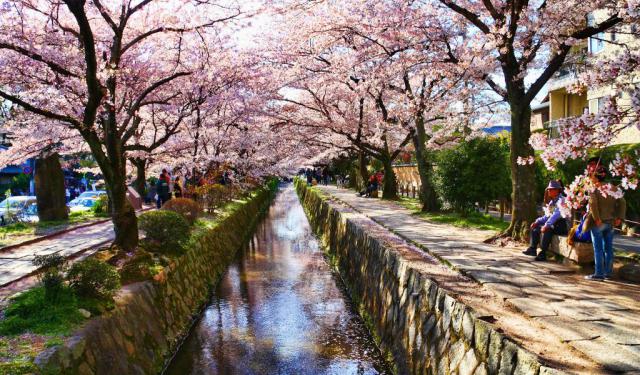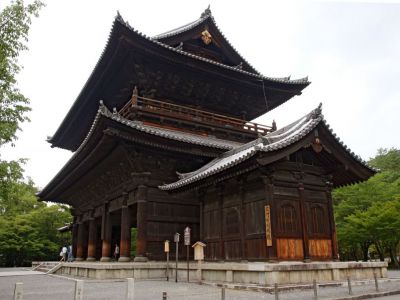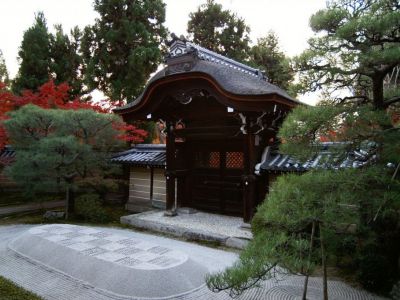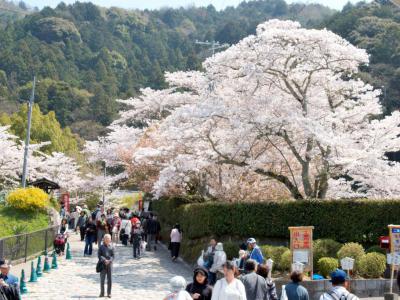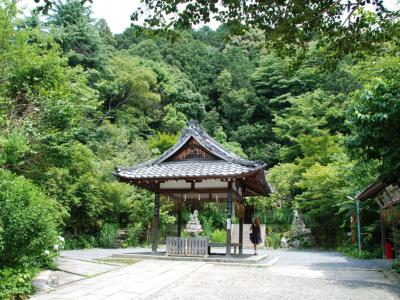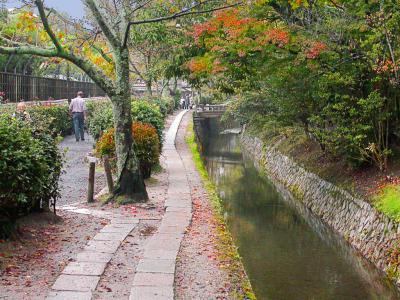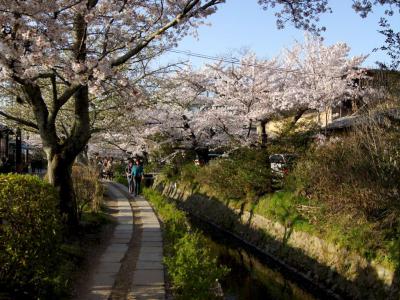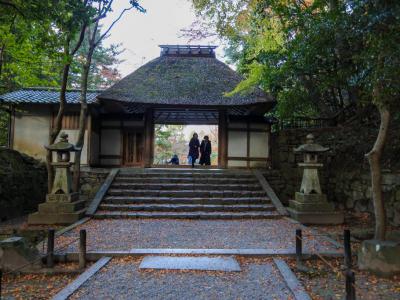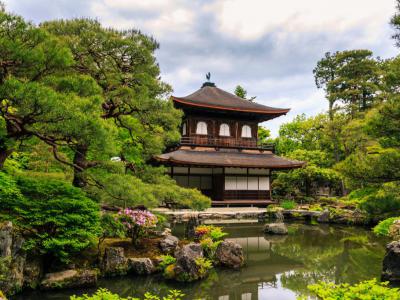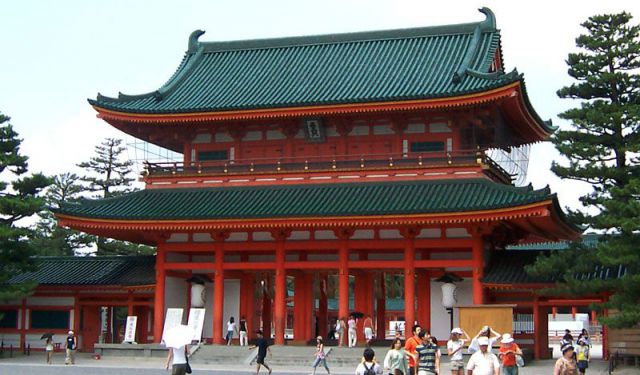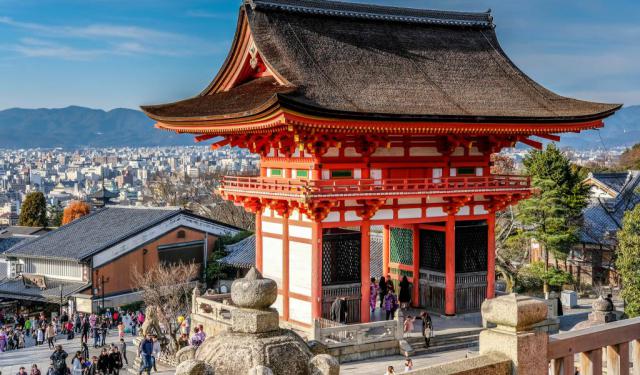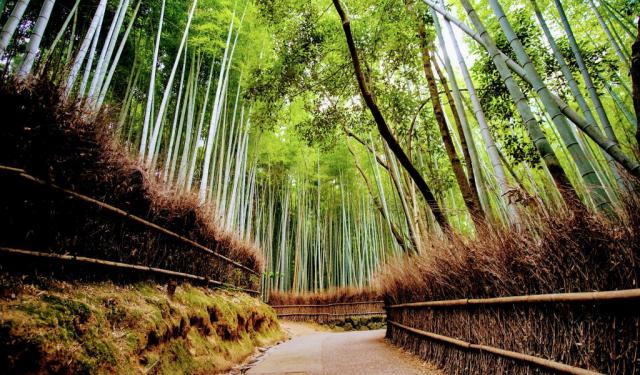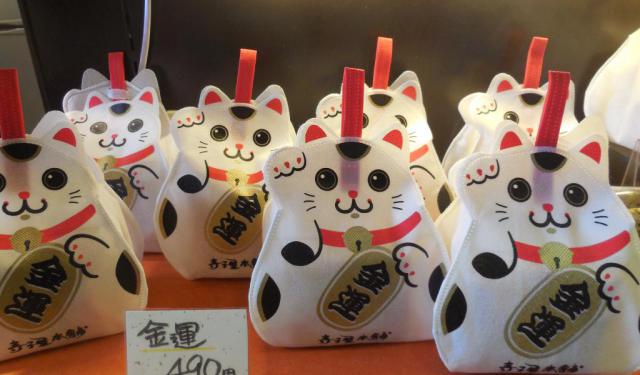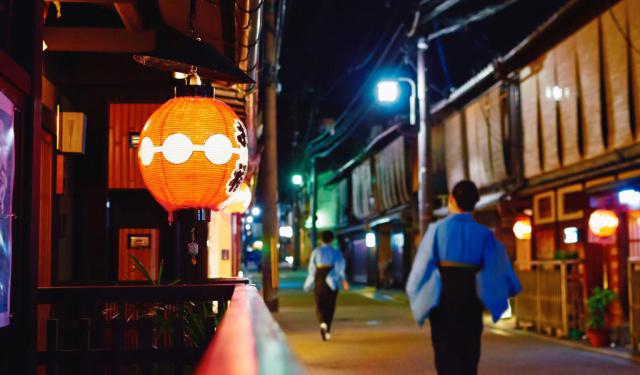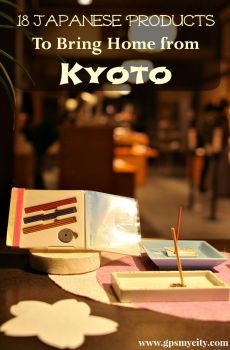Audio Guide: Walk on Philosopher's Path (Self Guided), Kyoto
Looking for a scenic walk with a side of existential pondering in Kyoto, you're inevitably bound to end up on the Philosopher’s Path. Winding its way for about two kilometers along the leafy canal that carries water from Lake Biwa to the foothills, this picturesque walking trail once served as the thinking route of Nishida Kitaro. Back in the first half of the 20th century, the famed Japanese philosopher walked this route lined with cherry trees to clear his head as a part of his daily meditation routine. So, if you’re overdue for a life epiphany or just want to stretch your legs while pretending to be deep in thought, this spot is for you. As a bonus, you'll get cherry blossoms in spring, golden leaves in fall, and serenity all year round.
The trail starts at the historic Nanzen-ji Temple, where Zen meets grand architecture and moss does what moss does best-make everything look ancient and wise. A little further up, Eikan-do Zenrin-ji Temple pulls out all the stops with blazing autumn foliage that’s practically begging to be on a postcard.
Heading south, you’ll encounter small yet charming Otoyo Shrine, delightfully tucked away amid the greenery, guarded by stone mice-yes, really. Further along, Daitoyo Bridge marks a scenic spot where you can experience one of those perfect “pause-and-ponder” moments, and just when you think you’ve peaked, Sakurabashi Bridge leads you to Honen-in Temple, a quiet retreat with moss-covered charm and just the right amount of mystery.
Continuing on the path eventually brings you to Ginkaku-ji Temple, also known as the Silver Pavilion, which isn’t actually silver, but it more than makes up for it with sublime mountain views and a meditative garden.
Meandering along the Philosopher's Path, expect to see huge koi fish, quaint local shops, galleries, and small cafés whispering, “Just one more matcha latte.” And if the weather is nice, you may usually find artists selling painted postcards and the like at reasonable prices.
To fully enjoy it, start early in the day rather than later, because there are quite a few things there to get lost in! Take your time-walk slow and let the path do the talking...
The trail starts at the historic Nanzen-ji Temple, where Zen meets grand architecture and moss does what moss does best-make everything look ancient and wise. A little further up, Eikan-do Zenrin-ji Temple pulls out all the stops with blazing autumn foliage that’s practically begging to be on a postcard.
Heading south, you’ll encounter small yet charming Otoyo Shrine, delightfully tucked away amid the greenery, guarded by stone mice-yes, really. Further along, Daitoyo Bridge marks a scenic spot where you can experience one of those perfect “pause-and-ponder” moments, and just when you think you’ve peaked, Sakurabashi Bridge leads you to Honen-in Temple, a quiet retreat with moss-covered charm and just the right amount of mystery.
Continuing on the path eventually brings you to Ginkaku-ji Temple, also known as the Silver Pavilion, which isn’t actually silver, but it more than makes up for it with sublime mountain views and a meditative garden.
Meandering along the Philosopher's Path, expect to see huge koi fish, quaint local shops, galleries, and small cafés whispering, “Just one more matcha latte.” And if the weather is nice, you may usually find artists selling painted postcards and the like at reasonable prices.
To fully enjoy it, start early in the day rather than later, because there are quite a few things there to get lost in! Take your time-walk slow and let the path do the talking...
How it works: Download the app "GPSmyCity: Walks in 1K+ Cities" from Apple App Store or Google Play Store to your mobile phone or tablet. The app turns your mobile device into a personal tour guide and its built-in GPS navigation functions guide you from one tour stop to next. The app works offline, so no data plan is needed when traveling abroad.
Walk on Philosopher's Path Map
Guide Name: Walk on Philosopher's Path
Guide Location: Japan » Kyoto (See other walking tours in Kyoto)
Guide Type: Self-guided Walking Tour (Sightseeing)
# of Attractions: 8
Tour Duration: 2 Hour(s)
Travel Distance: 2.6 Km or 1.6 Miles
Author: emma
Sight(s) Featured in This Guide:
Guide Location: Japan » Kyoto (See other walking tours in Kyoto)
Guide Type: Self-guided Walking Tour (Sightseeing)
# of Attractions: 8
Tour Duration: 2 Hour(s)
Travel Distance: 2.6 Km or 1.6 Miles
Author: emma
Sight(s) Featured in This Guide:
- Nanzen-ji Temple
- Eikan-do Zenrin-ji Temple
- Philosopher's Path: South End
- Otoyo Shrine
- Philosopher's Path: Daitoyo Bridge
- Philosopher's Path: Sakurabashi Bridge
- Honen-in Temple
- Ginkaku-ji Temple
1) Nanzen-ji Temple
If Zen had a penthouse suite, Nanzen-ji would be living in it. Once a piece of Japan’s Imperial Palace, this place got a fiery makeover during the Momoyama period (in the late 16th century) and rose from the ashes as one of Kyoto’s top-tier Zen temples. As such, it enjoys a very high status, sitting among gorgeous old homes that practically scream "vintage Kyoto" (minus the tourist frenzy of Gion, that is). Complete with rustling leaves and the occasional monk gliding past in straw hat and indigo robes, it creates an image that looks like it's just stepped off a scroll painting.
Prepare to be wowed by the temple's colossal two-story gate – a behemoth, not only by Japan's standards. Climbing up to its top for a sweeping view is well worth traversing the stairs. Then head to another star attraction, the Hojo Hall, with its sliding-door painting of a tiger quenching thirst from a stream alongside other dazzling gold leaf artworks.
Out back, the gardens – the handiwork of the landscaping legend Kobori Enshu from the early Edo period – are well worth the hype. And just when you think it can’t get any more photogenic, you stumble upon a 130-year-old red-brick aqueduct, channeling water from Lake Biwa to the city.
Perched on the edge of the eastern mountains, Nanzen-ji is ideal for slow-paced morning strolls, temple-deep dives or a full-blown day of exploration. Entry is usually free unless you’re eyeing some inner sanctums, which might cost you a few yen depending on your interests.
Tips:
Feeling fancy? Hop on a rickshaw for a scenic spin around the area.
For a serene detour, slip under the aqueduct and veer right (by the little stream) to climb up to a beautiful temple that most tourists miss.
Prepare to be wowed by the temple's colossal two-story gate – a behemoth, not only by Japan's standards. Climbing up to its top for a sweeping view is well worth traversing the stairs. Then head to another star attraction, the Hojo Hall, with its sliding-door painting of a tiger quenching thirst from a stream alongside other dazzling gold leaf artworks.
Out back, the gardens – the handiwork of the landscaping legend Kobori Enshu from the early Edo period – are well worth the hype. And just when you think it can’t get any more photogenic, you stumble upon a 130-year-old red-brick aqueduct, channeling water from Lake Biwa to the city.
Perched on the edge of the eastern mountains, Nanzen-ji is ideal for slow-paced morning strolls, temple-deep dives or a full-blown day of exploration. Entry is usually free unless you’re eyeing some inner sanctums, which might cost you a few yen depending on your interests.
Tips:
Feeling fancy? Hop on a rickshaw for a scenic spin around the area.
For a serene detour, slip under the aqueduct and veer right (by the little stream) to climb up to a beautiful temple that most tourists miss.
2) Eikan-do Zenrin-ji Temple (must see)
How about a temple that climbs like a stairway to heaven? A perfect blend of tradition and innovation, this one’s got all the classics-ancient halls, sacred statues, and serene gardens-but with a twist. There’s a small entrance fee, sure, but it's worth every penny of it as a ticket to one of Kyoto’s most delightful architectural surprises. The unassuming exterior may deceive you at first, but once you step inside, prepare to be blown away. Built right into the hillside, the complex unfurls upward like a giant, sacred treehouse-no rope ladders, just a lot of stairs and even more wow.
In autumn, the scenery is a knockout, especially when the foliage turns the place into a technicolor dream. Picture-perfect Japanese maples and ginkgos flaunt a kaleidoscope of hues, throwing shade in golden yellows, fiery reds, and the occasional moody purple. Pro tip: Climb to the two-story pagoda for the ultimate leaf-peeping experience! And if you time it right, late November brings after-dark illuminations that make the whole hillside glow like a lantern-lit fantasy.
However, the temple’s main claim to fame is Amida Buddha, a statue with a mind of its own-or at least a good sense of urgency. Designated as an Important Cultural Property of Japan, this isn't your average Buddha-instead of gazing forward, it glances over its shoulder, mid-turn. According to legend, back in 1082, Abbot Eikan had a divine encounter while chanting Nembutsu – a Buddhist practice of reciting the name of Amida Buddha, typically with the phrase "Namu Amida Butsu", which means "I take refuge in Amida Buddha." In response, the statue sprang to life, urging the monk to "hurry up" (because spiritual enlightenment waits for no one). That moment still lives on in the upper temple's main icon, immortalizing Eikan's celestial rendezvous and honoring the devout monk.
Before you go: grab a moment of Zen at the quaint little rest area near the entrance-snag a seat and soak in the quiet vibes and the view made for daydreaming framed by the wide windows. Also, don’t miss the suikinkutsu-a quirky, water-powered instrument that serenades you with soothing sounds when you pour water into it. You may be surprised, but enlightenment does have a soundtrack...
In autumn, the scenery is a knockout, especially when the foliage turns the place into a technicolor dream. Picture-perfect Japanese maples and ginkgos flaunt a kaleidoscope of hues, throwing shade in golden yellows, fiery reds, and the occasional moody purple. Pro tip: Climb to the two-story pagoda for the ultimate leaf-peeping experience! And if you time it right, late November brings after-dark illuminations that make the whole hillside glow like a lantern-lit fantasy.
However, the temple’s main claim to fame is Amida Buddha, a statue with a mind of its own-or at least a good sense of urgency. Designated as an Important Cultural Property of Japan, this isn't your average Buddha-instead of gazing forward, it glances over its shoulder, mid-turn. According to legend, back in 1082, Abbot Eikan had a divine encounter while chanting Nembutsu – a Buddhist practice of reciting the name of Amida Buddha, typically with the phrase "Namu Amida Butsu", which means "I take refuge in Amida Buddha." In response, the statue sprang to life, urging the monk to "hurry up" (because spiritual enlightenment waits for no one). That moment still lives on in the upper temple's main icon, immortalizing Eikan's celestial rendezvous and honoring the devout monk.
Before you go: grab a moment of Zen at the quaint little rest area near the entrance-snag a seat and soak in the quiet vibes and the view made for daydreaming framed by the wide windows. Also, don’t miss the suikinkutsu-a quirky, water-powered instrument that serenades you with soothing sounds when you pour water into it. You may be surprised, but enlightenment does have a soundtrack...
3) Philosopher's Path: South End (must see)
If you start on the Philosopher’s Path at the Nyakuoji Bridge, this south-end stretch of the Path offers far more than just a stroll along the scenic canal and canal-side contemplation.
About 20 meters to the left of the bridge, you’ll stumble upon SAYUU, an arts-and-crafts gallery so refined it could convince your suitcase to grow extra space. Open Thursday through Monday, from 11 AM to 6 PM, it’s a treasure trove of elegant glass and pottery at pocket-friendly prices.
Now pivot right and walk 50 meters to find the small and welcoming KUMANO NYAKUOJI-JINJA-a peaceful shrine that somehow slipped under the tourist radar. Open from 9 AM to 5 PM and originally established in 1160, it honors the god of academic brilliance and business success. Legend has it that Yatagarasu, the mythical three-legged raven, dwells within, serving the god as a messenger. Keep an eye out for its symbols on the roof tiles and in the "Kumanogongen" calligraphy of the main shrine. A sanctuary of tranquility, the surrounding park (and a conservation area) exudes peace and quiet, while the waterside provides a serene communion with nature throughout the year.
Those with a serious sweet tooth may hop across the river straight to KANOU, a confectionery shop and teahouse where they can enjoy their sweets and become one with their matcha without feeling rushed. Open from 10 AM till 8 PM, it’s a perfect finale for your soul-soothing detour-proof that a sweet ending is not just for fairy tales...
About 20 meters to the left of the bridge, you’ll stumble upon SAYUU, an arts-and-crafts gallery so refined it could convince your suitcase to grow extra space. Open Thursday through Monday, from 11 AM to 6 PM, it’s a treasure trove of elegant glass and pottery at pocket-friendly prices.
Now pivot right and walk 50 meters to find the small and welcoming KUMANO NYAKUOJI-JINJA-a peaceful shrine that somehow slipped under the tourist radar. Open from 9 AM to 5 PM and originally established in 1160, it honors the god of academic brilliance and business success. Legend has it that Yatagarasu, the mythical three-legged raven, dwells within, serving the god as a messenger. Keep an eye out for its symbols on the roof tiles and in the "Kumanogongen" calligraphy of the main shrine. A sanctuary of tranquility, the surrounding park (and a conservation area) exudes peace and quiet, while the waterside provides a serene communion with nature throughout the year.
Those with a serious sweet tooth may hop across the river straight to KANOU, a confectionery shop and teahouse where they can enjoy their sweets and become one with their matcha without feeling rushed. Open from 10 AM till 8 PM, it’s a perfect finale for your soul-soothing detour-proof that a sweet ending is not just for fairy tales...
4) Otoyo Shrine
If you're strolling Kyoto’s Philosopher’s Path in search of something quietly bizarre and blissfully uncrowded, Otoyo Shrine is your low-key jackpot. This little shrine, hiding in plain sight, has been around since 887. Originally built to soothe the spirit of Emperor Uda’s late father, Emperor Koko (because dynastic ghost management was very much a thing back then), it has since taken on the role of local spiritual bouncer, offering blessings for health, longevity, and general good vibes.
What makes Otoyo Shrine stand out, especially for curious visitors, is its quirky charm and animal symbolism. While most shrines in Kyoto boast the usual lion-dog statues guarding the entrance, Otoyo flips the script with… mice. Yes, stone mice. Not your typical temple gatekeepers, but here they are, looking surprisingly smug for rodents.
Observe closely and you'll notice one clutching a sake bottle-believed to bestow luck, fertility, and long life upon worshippers-while the other carries a scroll symbolizing academic prowess (presumably for acing exams or at least avoiding spelling errors on fortune slips). Legend has it that these mice once saved the shrine's main deity from going up in flames, a tale immortalized within the shrine's tiny wooden hall. Noble. Unexpected. Extremely on-brand for a place that also features hawk and monkey guardian statues (at smaller sub-shrines).
This lineup of spiritual sidekicks makes the whole site feel like a menagerie of spiritual symbolism. Adding to the whimsy are playful Chinese Zodiac figurines scattered throughout the grounds, alongside symbolic trees like camellia and weeping plums.
In spring, the shrine is especially lovely, when cherry blossoms dust the grounds in soft pink, adding a gentle touch to the tranquil setting. Similar to other spots along the Philosopher's Path, the unpretentious yet delightful gardens of Otoyo Shrine engender a sense of calm and serenity, welcoming visitors at no charge. Ideal for travelers looking for something low-key, local, and a little bit unusual.
What makes Otoyo Shrine stand out, especially for curious visitors, is its quirky charm and animal symbolism. While most shrines in Kyoto boast the usual lion-dog statues guarding the entrance, Otoyo flips the script with… mice. Yes, stone mice. Not your typical temple gatekeepers, but here they are, looking surprisingly smug for rodents.
Observe closely and you'll notice one clutching a sake bottle-believed to bestow luck, fertility, and long life upon worshippers-while the other carries a scroll symbolizing academic prowess (presumably for acing exams or at least avoiding spelling errors on fortune slips). Legend has it that these mice once saved the shrine's main deity from going up in flames, a tale immortalized within the shrine's tiny wooden hall. Noble. Unexpected. Extremely on-brand for a place that also features hawk and monkey guardian statues (at smaller sub-shrines).
This lineup of spiritual sidekicks makes the whole site feel like a menagerie of spiritual symbolism. Adding to the whimsy are playful Chinese Zodiac figurines scattered throughout the grounds, alongside symbolic trees like camellia and weeping plums.
In spring, the shrine is especially lovely, when cherry blossoms dust the grounds in soft pink, adding a gentle touch to the tranquil setting. Similar to other spots along the Philosopher's Path, the unpretentious yet delightful gardens of Otoyo Shrine engender a sense of calm and serenity, welcoming visitors at no charge. Ideal for travelers looking for something low-key, local, and a little bit unusual.
5) Philosopher's Path: Daitoyo Bridge
Just past the southern end of Kyoto’s Philosopher’s Path, the Daitoyo Bridge makes a humble entrance-stone-built, no-frills, and perfectly content to let the cherry blossoms steal the spotlight. It arches quietly over a sliver of the Lake Biwa Canal, not trying to impress, just doing its job with centuries-old grace. Think of it less as a tourist attraction and more as a scene-stealing extra in Kyoto’s greatest slow walk.
The bridge gets its name from the nearby Otoyo Shrine, a low-key but historically rich Shinto hideaway that’s been around since the early Heian period. This part of town skips the souvenir shops and bus tours, favoring whispering leaves, temple bells in the distance, and that one cat who absolutely owns the canal path.
For visitors, Daitoyo marks a kind of tonal shift-a polite suggestion to slow their steps, lower their voice, and maybe, just maybe, try to blend in with the serenity. Spring dresses it in petals, autumn frames it in gold. And the soundtrack? Trickling water, the hum of cicadas, and your own thoughts catching up with you.
Now, if tranquility stirs a sudden craving for silk and caffeine, you’re in luck. Just nearby, the FUMIMARO shop lures passersby with antique kimonos-real vintage, real silk, and surprisingly fair prices-then seals the deal with a hidden café in the back. Keep walking and you’ll hit KOMICHI, an old-school “kissaten”-style coffee shop with a window into Showa-era Kyoto: light noodle dishes and rice bowls, jazz on the speakers, and an array of Japanese-style desserts that make you rethink your pace... yet again.
The bridge gets its name from the nearby Otoyo Shrine, a low-key but historically rich Shinto hideaway that’s been around since the early Heian period. This part of town skips the souvenir shops and bus tours, favoring whispering leaves, temple bells in the distance, and that one cat who absolutely owns the canal path.
For visitors, Daitoyo marks a kind of tonal shift-a polite suggestion to slow their steps, lower their voice, and maybe, just maybe, try to blend in with the serenity. Spring dresses it in petals, autumn frames it in gold. And the soundtrack? Trickling water, the hum of cicadas, and your own thoughts catching up with you.
Now, if tranquility stirs a sudden craving for silk and caffeine, you’re in luck. Just nearby, the FUMIMARO shop lures passersby with antique kimonos-real vintage, real silk, and surprisingly fair prices-then seals the deal with a hidden café in the back. Keep walking and you’ll hit KOMICHI, an old-school “kissaten”-style coffee shop with a window into Showa-era Kyoto: light noodle dishes and rice bowls, jazz on the speakers, and an array of Japanese-style desserts that make you rethink your pace... yet again.
6) Philosopher's Path: Sakurabashi Bridge
If you ever find yourself strolling Kyoto’s Philosopher’s Path, deep in thought or just pretending to be, Sakurabashi Bridge is your cue to pause, breathe, and maybe question whether cherry blossoms were always this photogenic. Not exactly ancient, but definitely charming, this overpass, whose name translates to "Cherry Blossom Bridge," lives up to its name every spring when the sakura trees go full diva, turning the canal into a soft-focus daydream.
Unlike the headline-hogging temples nearby, Sakurabashi is blissfully off the radar. You’ll find no crowds, no queues, and no tour buses. Just a few understated cafés-one even run by Kyoto’s favorite skincare brand, Yojiya-where you can sip matcha and contemplate life, or at least your next snack.
Timing is everything: late March to early April is peak hanami mode, when the air smells like petals and every step is Instagram bait. Come early for peace and pink serenity, and don’t forget your camera-or your inner haiku poet. If hunger strikes, there’s The Diner nearby, with welcoming English-speaking staff, serving up Western-style cuisine, like Philly cheesesteaks, prepared with Japanese finesse. Yes, that’s a thing. No, you don’t need to understand it. Just enjoy.
Art lovers can wander into Gallery Takano, a woodblock-print haven run by folks who love art enough to actually talk about it. And if you're a history buff, keep walking and you’ll find the unassuming tomb of Emperor Reizei, Japan's sixty-third Emperor, whose brief reign (from 967 to 969) was cut short by ill health-a mossy, slightly forgotten patch of imperial mystery. Just check in with the gatekeeper before tiptoeing into the past.
Sakurabashi may not be loud, flashy, or ancient, but it gets Kyoto-quiet, layered, and always one petal away from sublime.
Unlike the headline-hogging temples nearby, Sakurabashi is blissfully off the radar. You’ll find no crowds, no queues, and no tour buses. Just a few understated cafés-one even run by Kyoto’s favorite skincare brand, Yojiya-where you can sip matcha and contemplate life, or at least your next snack.
Timing is everything: late March to early April is peak hanami mode, when the air smells like petals and every step is Instagram bait. Come early for peace and pink serenity, and don’t forget your camera-or your inner haiku poet. If hunger strikes, there’s The Diner nearby, with welcoming English-speaking staff, serving up Western-style cuisine, like Philly cheesesteaks, prepared with Japanese finesse. Yes, that’s a thing. No, you don’t need to understand it. Just enjoy.
Art lovers can wander into Gallery Takano, a woodblock-print haven run by folks who love art enough to actually talk about it. And if you're a history buff, keep walking and you’ll find the unassuming tomb of Emperor Reizei, Japan's sixty-third Emperor, whose brief reign (from 967 to 969) was cut short by ill health-a mossy, slightly forgotten patch of imperial mystery. Just check in with the gatekeeper before tiptoeing into the past.
Sakurabashi may not be loud, flashy, or ancient, but it gets Kyoto-quiet, layered, and always one petal away from sublime.
7) Honen-in Temple
Tucked away from Kyoto’s temple tourist circuit is a mossy little marvel built to honor Honen, the guy who kickstarted the Jodo Shu sect of Zen Buddhism back in 1175. In a way, this is the introvert of Kyoto temples-low-key, contemplative, and covered head to toe in velvety green moss. The gate alone, with its charming thatched roof, is begging for a photo op, and it opens into a postcard-ready garden complete with a stone bridge and a pond that looks like it was designed by a poet on a tea break.
The best part is that the entry is gloriously free-unless you show up during camellia season in April or autumn’s grand finale in November, when the main hall makes a brief, dramatic appearance like a shy celebrity at a red carpet event. Inside, you’ll find sliding screens painted by Kano School artists, including a dreamy piece called Soft Breeze Approaching, where the Pure Land shimmers beneath willow trees like a Buddhist fever dream.
Take your time meandering past sculpted sand mounds and seasonal sand art installations, which might just outshine your Instagram filter. Just past the garden, you’ll stumble upon the final resting place of Jun'ichiro Tanizaki, a luminary of modern Japanese literature, and other literary greats.
And before you leave, here’s a hot tip: there’s a secret grotto hiding in plain sight. It’s nestled somewhere between the tranquility and the raked gravel. Go find it-you’ll earn bragging rights and maybe a moment of actual inner peace.
The best part is that the entry is gloriously free-unless you show up during camellia season in April or autumn’s grand finale in November, when the main hall makes a brief, dramatic appearance like a shy celebrity at a red carpet event. Inside, you’ll find sliding screens painted by Kano School artists, including a dreamy piece called Soft Breeze Approaching, where the Pure Land shimmers beneath willow trees like a Buddhist fever dream.
Take your time meandering past sculpted sand mounds and seasonal sand art installations, which might just outshine your Instagram filter. Just past the garden, you’ll stumble upon the final resting place of Jun'ichiro Tanizaki, a luminary of modern Japanese literature, and other literary greats.
And before you leave, here’s a hot tip: there’s a secret grotto hiding in plain sight. It’s nestled somewhere between the tranquility and the raked gravel. Go find it-you’ll earn bragging rights and maybe a moment of actual inner peace.
8) Ginkaku-ji Temple (must see)
You know you’re fancy when your retirement home becomes a UNESCO World Heritage Site. That’s exactly what happened to Yoshimasa, the eighth Ashikaga shogun, who picked this peaceful patch of Kyoto as his personal endgame-and in the process, helped perfect the art of the Japanese tea ceremony. Welcome to Ginkaku-ji, a 15th-century Zen temple often nicknamed the “Silver Pavilion.” The twist is that it’s not actually silver. That glimmer you see is just moonlight flirting with its once-black lacquered walls-nature’s optical illusion at its finest...
But the sparkle doesn’t stop there. Often called the 'little sibling' of Kinkaku-ji (or Golden Pavilion), it boasts even more scenic and exquisite gardens. The real scene-stealer is the 1.75-acre dry sand garden-a flawlessly raked expanse meant to reflect moonlight like a silvery sea. At its heart stands a conical mound modeled after Mount Fuji, proof that Zen monks could outdo any landscaper with a rake and a dream.
Take the Moon-Viewing Platform, then follow the winding path through mossy gardens, over quaint bridges, past koi ponds and whispering streams. It'll lead you to a hilltop view that rolls out the entire temple complex-and most of Kyoto, if you're lucky. The stone-and-bamboo walkway keeps things civilized, so even the uphill part feels like a meditative stroll.
Yes, it gets crowded. But thanks to the one-way route, you won’t be playing tourist bumper cars. Just zen out and go with the flow.
What you'll get in the end is garden perfection, bamboo vibes, and moonlit drama, not to mention a gift shop full of rabbit-themed treasures (that you didn’t even know you needed) and fan souvenirs not found anywhere else in Kyoto...
Pro tip: Hit it early or at golden hour. Kyoto sunsets are too pretty to miss...
But the sparkle doesn’t stop there. Often called the 'little sibling' of Kinkaku-ji (or Golden Pavilion), it boasts even more scenic and exquisite gardens. The real scene-stealer is the 1.75-acre dry sand garden-a flawlessly raked expanse meant to reflect moonlight like a silvery sea. At its heart stands a conical mound modeled after Mount Fuji, proof that Zen monks could outdo any landscaper with a rake and a dream.
Take the Moon-Viewing Platform, then follow the winding path through mossy gardens, over quaint bridges, past koi ponds and whispering streams. It'll lead you to a hilltop view that rolls out the entire temple complex-and most of Kyoto, if you're lucky. The stone-and-bamboo walkway keeps things civilized, so even the uphill part feels like a meditative stroll.
Yes, it gets crowded. But thanks to the one-way route, you won’t be playing tourist bumper cars. Just zen out and go with the flow.
What you'll get in the end is garden perfection, bamboo vibes, and moonlit drama, not to mention a gift shop full of rabbit-themed treasures (that you didn’t even know you needed) and fan souvenirs not found anywhere else in Kyoto...
Pro tip: Hit it early or at golden hour. Kyoto sunsets are too pretty to miss...
Walking Tours in Kyoto, Japan
Create Your Own Walk in Kyoto
Creating your own self-guided walk in Kyoto is easy and fun. Choose the city attractions that you want to see and a walk route map will be created just for you. You can even set your hotel as the start point of the walk.
Imperial Kyoto Walking Tour
Kyoto served as Japan’s imperial capital for over 1,000 years, from 794 to 1869, beginning with Emperor Kanmu’s relocation of his court to Heian-kyō (which is Kyoto’s former name). Though political power eventually shifted to the shogunate and later to Tokyo, Kyoto remained the cultural and symbolic heart of Japan. Its long association with the imperial court helped shape it into a refined... view more
Tour Duration: 2 Hour(s)
Travel Distance: 4.1 Km or 2.5 Miles
Tour Duration: 2 Hour(s)
Travel Distance: 4.1 Km or 2.5 Miles
Higashiyama Walking Tour
It'd be fair to say that Kyoto is a theme park for lovers of history, religion, and all things deeply, unmistakably Japanese. If so, Higashiyama Ward, with its long lines, can easily be recognized as its star attraction. Tucked along the city’s eastern edge-hence its poetic name translated as “Eastern Mountain”-this district is where Kyoto flaunts its heritage like a geisha in full... view more
Tour Duration: 1 Hour(s)
Travel Distance: 2.6 Km or 1.6 Miles
Tour Duration: 1 Hour(s)
Travel Distance: 2.6 Km or 1.6 Miles
Arashiyama and Bamboo Grove Walking Tour
The Arashiyama district of Kyoto is slightly out of the way for tourists, but that means you can enjoy it more comfortably.
Undoubtedly, the most popular attraction here is the iconic Bamboo Grove, a mesmerizing forest of towering bamboo stalks that sway gently in the breeze, creating an ethereal atmosphere. This serene setting is a must-visit for travelers seeking tranquility amidst... view more
Tour Duration: 2 Hour(s)
Travel Distance: 3.4 Km or 2.1 Miles
Undoubtedly, the most popular attraction here is the iconic Bamboo Grove, a mesmerizing forest of towering bamboo stalks that sway gently in the breeze, creating an ethereal atmosphere. This serene setting is a must-visit for travelers seeking tranquility amidst... view more
Tour Duration: 2 Hour(s)
Travel Distance: 3.4 Km or 2.1 Miles
Kyoto Shopping and Food Tour
The cultural capital of Japan, Kyoto is just as famous as a shopper’s paradise and, without a doubt, the best place in the country to buy traditional and modern Japanese goods. Souvenirs, food, bargains, and various “one-of-a-kind items” are all up for grabs here.
In addition to its shopping scene, Kyoto boasts a rich culinary heritage, from Michelin-starred restaurants to humble street... view more
Tour Duration: 1 Hour(s)
Travel Distance: 2.0 Km or 1.2 Miles
In addition to its shopping scene, Kyoto boasts a rich culinary heritage, from Michelin-starred restaurants to humble street... view more
Tour Duration: 1 Hour(s)
Travel Distance: 2.0 Km or 1.2 Miles
Gion District Walking Tour
Gion, one of Kyoto’s most captivating districts, is deeply rooted in Japan’s cultural heritage. Located in the Higashiyama (the so-called “Eastern Mountain”) neighborhood, its history dates back to the Sengoku period, when it began as a hospitality area for pilgrims visiting Yasaka Shrine. By the late 18th and early 19th centuries, it had evolved into a renowned entertainment quarter,... view more
Tour Duration: 2 Hour(s)
Travel Distance: 2.8 Km or 1.7 Miles
Tour Duration: 2 Hour(s)
Travel Distance: 2.8 Km or 1.7 Miles
Useful Travel Guides for Planning Your Trip
18 Japanese Products To Bring Home from Kyoto
The old capital of Japan, the city of Kyoto has once again been the talk of the world lately, thanks to the bestselling "Memoirs of a Geisha" book and the namesake Hollywood blockbuster movie. Renowned for its impeccable craftsmanship, Japan has so much to amaze a foreign eye with. Many of...
The Most Popular Cities
/ view all
